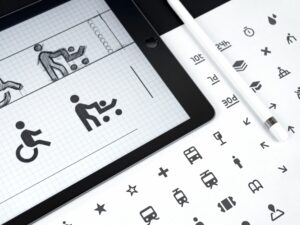Icons are mainly used on several user interfaces to present objects, actions, and ideas visually. The core intent and idea of a product or service can be communicated effectively if they’re used correctly. Additionally, they bring several benefits to the website, such as saving of screen space and enhancement in aesthetic appeal.
This is the reason why most of the apps and websites use icons. Despite such advantages, icons can create negative user experiences if they’re not placed on websites the right way. This happens mostly when the designers hide functionalities behind the icons, thus confusing the users. Icons must guide users in the right direction and this is their primary function.
Types of Icons
A product, service, action, or idea must be presented well with the use of icons. If this is not done, they’re reduced to just a visual noise causing hindrances to the site’s visitors. Universal, conflicting, and unique icons are the three types you’ll generally come across. Each of them can be described as given below:
1. Universal icons: There are a few icons that enjoy a universal recognition. Among them are the ones used to indicate home, search, and a shopping cart. Any other icon used for indicating such things can confuse the users. Their meaning can also differ depending on the interface.
2. Conflicting icons: Commonly used pictograms can lead to contradictory meanings when used on the website. The most suitable examples in this context are the heart and star icons. The functionality indicated by these two icons vary from app to app.
It is this conflict that makes these icons difficult to interpret. The user may expect a particular outcome and get something different. This acts as an impediment to the user’s understanding of these icons.
3. Unique icons: They are a bad choice for anything abstract and fail to convey a concept. As they are not strong visual representations of the concept, they fail in guiding the users. One of the best examples would be the icon for Apple’s Game Center app. The icon is presented as a group of colorful circles. It doesn’t relate to gaming in any way.
Simple strategies for choosing an appropriate icon
There are some simple techniques and strategies that can be quite effective in choosing a proper icon. Using them, the designers can create the best user experiences by avoiding confusions. Here are some of the strategies that can be extremely useful:
1. Using labels to clarify unfamiliar icons: To create a good user experience, it is necessary that the user is not made to think too much. Including a text label can be an effective way of clarifying the meaning of an icon. The user must have clarity on what’s going to happen before he or she performs an action.
2. Making icons ideal for touch-based interfaces: People interact with interfaces that are touch-based by using their fingers. It is, therefore, necessary that the icons be big enough for correctly capturing the actions of fingertips. Users generally get frustrated with tiny icons that trigger unintended actions.
3. Test the icons well before implementation: Before the icons are included in the design of a website or app, they must be tested for usability. It is done by observing how a first-time user interacts with the user interface. This helps in determining whether the icons are clear enough for the user and are of the appropriate size.






